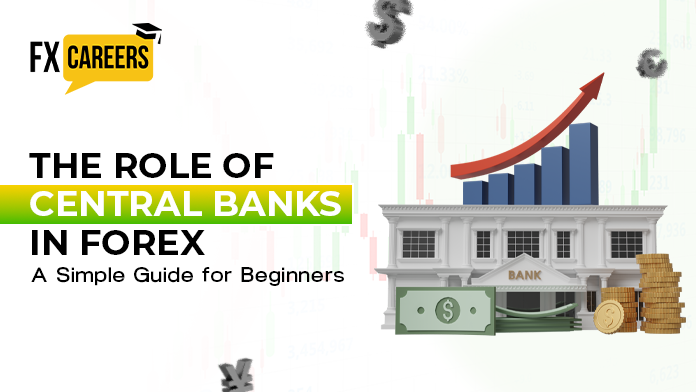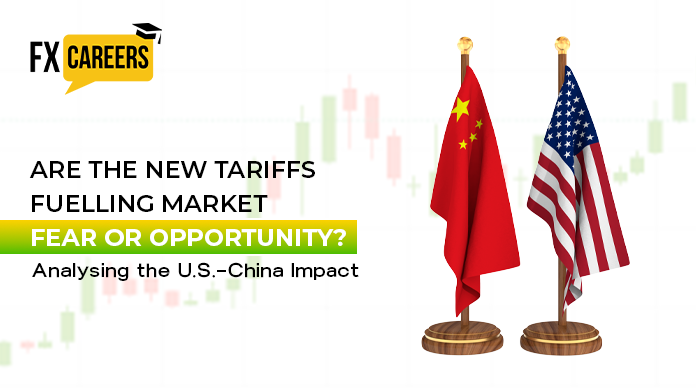FXCareers Blogs
 Go Back Home
Go Back Home
.png)
 18-09-2025
18-09-2025 5 minutes of Reading
5 minutes of Reading
Forex Trading During a Financial Crisis: Strategies, Risk Management, and Pro Tips
Financial markets are famously unpredictable and often crash without warning. During these times, many traders panic as their investments lose value. However, a group of professional traders not only survives but also finds ways to profit.
This article explains how these traders approach forex trading during a financial crisis, focusing on practices standard in the UAE and Indian markets.
When a financial crisis hits, people's behaviour changes. Calm, rational traders often become scared and make impulsive decisions, abandoning their plans. Professional traders understand this shift in psychology.
They know that most people will panic and sell off their investments. Professional traders stay calm. They buy when others are selling in a panic and sell when demand increases, taking advantage of the market's irrational behaviour.
Let's see how professional traders approach during a financial Crisis.
Trading Forex During a Financial Crisis
During a financial crisis, professional traders often approach the forex market differently than they do in stable times. Instead of just betting on a currency's rise, they use strategies that benefit from volatility and fear. Here's how they do it:
- Focus on safe-haven currencies: When global financial markets get shaky, investors often sell risky assets and buy "safe-haven" currencies. These are currencies from countries with stable political and economic systems, like the Japanese Yen (JPY), Swiss Franc (CHF), and US Dollar (USD). Professional traders often buy these currencies, expecting their value to rise as panic spreads.
- Use volatility to your advantage: Financial crises create huge swings in currency values. Instead of being scared by this volatility, experienced traders embrace it. They use strategies like breakout trading, where they wait for a currency pair to move sharply in one direction and then jump on the trend. They also use a wide stop-loss to avoid being knocked out of a trade by sudden, large price movements.
- Monitor central bank actions: During a crisis, central banks often intervene with significant announcements or policy changes, such as cutting interest rates or implementing quantitative easing. These actions can cause massive and immediate shifts in currency values. Professional traders pay close attention to these announcements, often trading in the minutes or hours following them to capitalise on the market's reaction.
- Trade with the trend, not against it: When panic sets in, markets tend to trend strongly in one direction. For example, riskier currencies may fall sharply against safe havens. Professional traders understand this and typically refrain from trying to "buy the dip" too early. Instead, they wait for a clear trend to establish itself and then trade in the same direction, a practice known as trend-following.
By focusing on these strategies, professional traders can navigate the forex market during a financial crisis and, in some cases, even profit from the chaos.
Managing Risk in Forex Trading During a Financial Crisis
During a financial crisis, the foreign exchange (forex) market becomes highly volatile. To protect themselves from huge losses and capitalise on opportunities, professional traders use strict risk management strategies. Here's how they do it:
- Protect Your Capital: The number one rule is to protect your money. Professional traders typically risk only a small percentage of their account on any single trade, often between 1% and 2%. This "fixed-percentage" method ensures that even if they have a string of losing trades, they don't wipe out their entire account.
- Use Stop-Loss Orders: A stop-loss is an automatic order that closes a trade when it reaches a certain price. During a crisis, prices can move dramatically and quickly. By setting a stop-loss, traders prevent a slight loss from becoming a catastrophic one. They calculate the stop-loss level based on their risk tolerance and the trade's specific volatility.
- Size Positions Correctly: Position sizing is the process of determining how much to invest in a single trade. It's a key part of risk management. A professional trader will adjust their position size based on how far away their stop-loss is. If the stop-loss is far away, they will take a smaller position to keep their risk at the same level. If the stop-loss is close, they can take a larger position.
- Focus on Risk-to-Reward Ratio: Professional traders always evaluate a trade's potential before they enter it. They aim for a risk-to-reward ratio that makes the trade worthwhile. For example, they might look for a trade where the potential profit is at least twice the loss . This ensures that a few winning trades can outweigh several losing ones.
- Manage Emotions: A financial crisis can trigger panic and impulsive decisions. Professional traders train themselves to stick to their plan no matter what. They understand that fear and greed can lead to poor choices, so they rely on their pre-defined strategies and risk management rules to guide their actions, not their feelings.
If you want to know how they develop a strong mindset, our blog post The Winning Mindset of a Successful Currency Trader explains the habits and beliefs that help them stay calm when the market turns volatile.
Advanced Forex Crisis Strategies Professional Traders Use During Financial Turmoil
When markets collapse and uncertainty grips the world, professional traders don't survive; they find ways to stay ahead. Retail traders often panic, but seasoned professionals apply advanced strategies designed for high-volatility environments.
Here are some of the most advanced forex crisis strategies during a financial crisis
1. Safe-Haven Currency Rotation
Pro traders quickly rotate their positions into currencies that historically hold value in crises. The Japanese Yen (JPY) and Swiss Franc (CHF) are classic safe havens. For example, during the 2008 crisis, JPY rose sharply as traders exited riskier assets.
Tips for retail traders: Keep an eye on sudden capital flows into these currencies when panic sets in.
2. Cross-Currency Hedging
Instead of trading only against the USD, advanced traders hedge risks through cross-currency pairs. For example, if the euro and pound both weaken, professionals might trade EUR/CHF or GBP/JPY to reduce exposure to the dollar's volatility.
3. Options and Derivatives for Risk Control
Options strategies, such as straddles and strangles, allow professionals to profit from extreme volatility without predicting direction. If EUR/USD is expected to swing wildly, buying both a call and a put option ensures gains if the move is sharp.
4. Scaling and Position Sizing
Professional traders rarely go "all in." They scale into trades using smaller positions and add more only when the market confirms the trend. This prevents catastrophic losses if sudden reversals occur.
5. Macro-Fundamental Analysis
Pros follow crisis indicators beyond forex charts. They track bond yields, credit spreads, and central bank liquidity injections. For example, if the U.S. Fed announces unlimited QE, professionals anticipate dollar weakness and adjust accordingly.
6. Diversification Across Asset Classes
Advanced traders don't confine themselves to currencies alone. They use gold, oil, and equities as correlated hedges. A long position in gold alongside a short in emerging-market currencies can balance risks effectively.
If you are new to advanced trading strategies, check out our guide on.
Key Takeaway: Professional traders treat a financial crisis as an opportunity rather than a disaster. By combining safe-haven flows, cross-currency hedging, derivatives, and disciplined risk management, they can adapt more quickly than retail traders.
Conclusion: Lessons That Never Expire
Crises will come again. No trader can prevent them.
Professionals prepare before they strike. They manage risk, employ proven strategies, and maintain emotional control.
For retail traders, the message is simple. Build your own crisis survival guide today. Treat capital as your lifeline respect volatility. Stay disciplined when fear dominates the screen.
Because in every crisis, opportunity exists for those who are ready.
If you're serious about building a career in trading, start by investing in your knowledge. Explore expert-led forex education programs at FXCareers and gain the skills you need to hedge effectively and trade with confidence.
Frequently asked questions
1. How do professional traders manage forex trading during a financial crisis?
They focus on capital preservation with smaller positions, strict stop-losses, and hedging strategies. They also monitor haven currencies and central bank actions.
2. What is the best risk management in forex trading during crises?
The best approach is to cut leverage, diversify trades, and never risk more than 1–2% of capital per trade.
3. What advanced forex crisis strategies do experts use?
They use volatility scalping, macro positioning, carry trade unwinds, and algorithmic alerts to spot sudden opportunities.
4. How important is trading psychology in market crashes?
It is crucial. Fear and greed can destroy discipline. Professionals train their minds to stay calm, accept losses, and avoid emotional trades.
5. What should a forex market crisis survival guide include?
It should outline leverage rules, focus on liquid pairs, scenario planning, and clear exit strategies.




